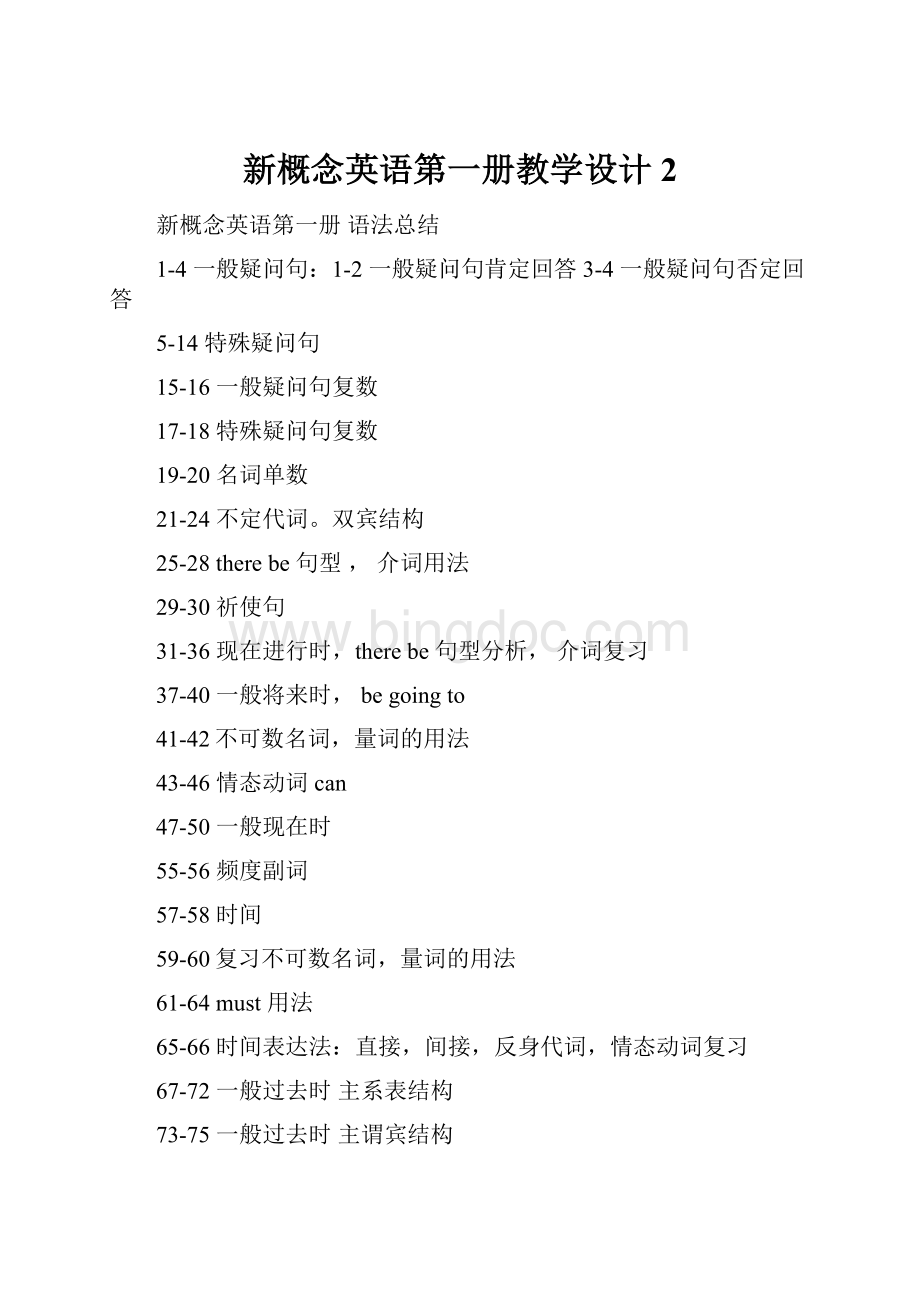新概念英语第一册教学设计2.docx
《新概念英语第一册教学设计2.docx》由会员分享,可在线阅读,更多相关《新概念英语第一册教学设计2.docx(116页珍藏版)》请在冰点文库上搜索。

新概念英语第一册教学设计2
新概念英语第一册语法总结
1-4一般疑问句:
1-2一般疑问句肯定回答3-4一般疑问句否定回答
5-14特殊疑问句
15-16一般疑问句复数
17-18特殊疑问句复数
19-20名词单数
21-24不定代词。
双宾结构
25-28therebe句型,介词用法
29-30祈使句
31-36现在进行时,therebe句型分析,介词复习
37-40一般将来时,begoingto
41-42不可数名词,量词的用法
43-46情态动词can
47-50一般现在时
55-56频度副词
57-58时间
59-60复习不可数名词,量词的用法
61-64must用法
65-66时间表达法:
直接,间接,反身代词,情态动词复习
67-72一般过去时主系表结构
73-75一般过去时主谓宾结构
77-78情态动词的否定疑问句,时间介词
79-80needmust情态动词
81-82to1Excuseme
1.Words
1)excuse
(1)重音
(2)与sorry的区别
(3)Excuse用的不同场景
a.请别人让路
b.引起别人的注意
c.打断别人的谈话
d.可以当n.借口eg.Noexcuse.别找借口,没有借口。
(举例)
2)this重点:
ð的发音
ðthisthatthosefathermotherbrotherthey
θthreethinkmouththankthing
P.S.Somethingisbetterthannothing.
3)Your重点:
人称代词与形容词性物主代词
复习:
人称代词(主格)
I
you
he
she
it
we
they
人称代词(宾格)
me
you
her
it
us
them
形容词性物主代词
my
your
his
her
its
our
their
Now,doexercise:
你的狗我的书他的女友她的爱人它的家我们的儿子他们的钱
2.Grammar
1)Yes?
用法:
(1)用于回答一般疑问句中肯定的形式:
eg.Yes,itis.
(2)=What’sup?
什么事?
Eg.Child:
“Father!
”Father:
”Yes?
”
2)一般现在时的常用用法及一般疑问句
(1)Now,doexercise:
a.这是一个包。
b.这是我的包。
c.这不是我的包。
d.这是你的包吗?
(2)一般疑问句的方式即是将be动词(amisare)提前,其余照抄即可。
其语法形态为:
Be(amisare)+主语+其余成分(表宾)
Now,doexercise:
a.这是一只狗。
这是一只狗吗?
b.这是他的狗。
这是他的狗吗?
c.这是她的CD机。
这是她的CD机吗?
d.这是我的男朋友。
这是你的男朋友吗?
e.他是我的男朋友。
他是你的男朋友吗?
f.她是我的继母。
她是你的继母吗?
g.他们是我们的儿子。
他们是你们的儿子吗?
’tisnot=isn’t
(4)一般疑问句的否定形式:
只须在be动词(amisare)后加上not即可。
Eg.Sheisabeautifulgirl.Sheisn’tabeautifulgirl.
Now,doexercise:
把(3)中的例句变为否定句
a.这不是一只狗,这是一只狼。
b.这不是他的狗,这是我的狗。
c.这不是她的CD机,这是你的CD机。
d.这不是我的男朋友,这是她的男朋友。
e.他不是我的男朋友,他是她的男朋友。
f.她不是我的继母,她是他的继母。
g.他们不是我们的儿子,他们是他们的儿子。
’tmentionit.
c.Notatall.
d.That’sallright.
e.Sure.
f.That’sOk.
g.It’snothing.
Lesson2
1)Word.
(1)pen–pencil–pencilbox–ballpen
(2)book–n.书例如:
我的书,你的书,他的书,她的书
-v.预定例如:
预定房间:
bookaroom
(3)watch–a.手表eg.这是你的手表吗?
b.小心Watchout!
=Lookout!
有关watchout的小故事。
c.Watch!
Watch!
小心!
小心!
有关故事
d.看WatchTV
(4)skirt–a.mini-skirtmini-car
b.s+ksgeg.skirtschool
s+psbeg.sportspace
s+tsdeg.starstudy
c.ir:
eg.girl
Now,doexerciese:
readthewordsbelow:
skyskispyspringstaystandbirdshirtskirt
(5)womandoctorstudentgentlemanladywaiterboygirl
Lesson3Sorry,Sir.
1.Words.
1)number–No.
2)Sorry–Stillyoucansay:
-I’msorry.
-I’msosorry.
-I’msorryaboutthat.
Answer:
-Nevermind.
-That’sallright.
-Itdoesn’tmatter.
3)m:
memoremother:
notnightnearnamenewcan
Now,read:
comemanmoonroomcomesmall
ongonesoonanyunderdown
P.S.Nonewsisgoodnews.
4)a.Sir先生,单独使用,千万不要说:
LiSir,WangSir.
b.Mr.先生,后面加人的姓,如:
Mr.LiMr.Jim(原型:
mister)
c.Mrs.夫人,用法同上
d.Miss小姐,可单独使用,也可后加人姓名,如:
MissJuliaRoberts
e.Madam女士,单独使用
f.Ma’ammæm女士,单独使用(往往用于年轻女士)
g.gentleman先生,单独使用。
请把我的钢笔给我。
i.Jack,请把我的迷你裙给我。
2)Hereis…这是…
a.把东西递给别人的时候。
b.把某物指给别人看的时候。
Eg.Here’smypen.
Here’smy.
4
1)Suit-a.一套西服套装
b.发音su:
tsju:
t
2)teacher–NeversayTeacherLi,youshouldsayMr.Mrs.MissLi.
3)Yourfamily
greatgrandfathergreatgrandmothergreatgrandsongreatgranddaughter
Grandmothergrandfathergrandmagrandpafathermother(daddy,mummy,dad,mum)
Uncleauntnephewniececousin(firstcousin父母的兄弟姐妹的孩子secondcousin父母的表兄弟、表姐妹的孩子)
brothersister(youngerelder)sondaughterlovechildren(私生子)
step-motherfathersisterbrothersondaughtermotherfathersisterbrother-in-law
4)Doexercise:
课后练习
5)补充内容:
Howdoyougreetothers?
-Howdoyoudo?
-Howareyou?
Howareyoutoday?
-Howareyoudoing?
-Howarethings?
-Howareyougettingon?
-How’severthinggoing?
-Hi!
-Hello!
Answer:
-Howdoyoudo?
-Fine,thankyou.Andyou?
-Justfine,thanks.
-Verywell.Howaboutyou?
-Notbad.Andyou?
-Prettygood.
-I’mdoingfine.
-Nottoowell.I5Nicetomeetyou
1.Words.
1)morning
(1)Timeinadaya.morning–inthe
b.noon–onthe
c.afternoon–inthe
d.evening–inthe
e.night–at
f.midnight–at
g.earlymorning–inthe
(2)a.secondminite(美国口语,女新闻记者)newsroom(新闻编辑室)newswindow(新闻图片栏)newssheet(小报)newsboy(送报纸的孩子)newsletter(时事通讯)
3)French–FrancePariscapital
Frenchbread(法国棍式面包)Frenchchalk(滑石粉)Frenchgrey(浅灰色)Frenchleave(不辞而别)Frenchwindow(落地窗)FrenchmanFrenchmenFrenchy(法国式的,法国风味的,(口)法国人)Frenchnose(鹰钩鼻)
4)German–Gremany
5)nice
(1).美好的,和蔼的,正派的,细微的,挑剔的,精密的,拘泥的
a.It’saniceday!
b.Heisaniceman.
c.Thisisanicevaze.
d.Whatanicelittlegirl!
(2)有关nice的几个短语:
niceandcool(凉快)niceNelly(装的归规矩局的人,委婉语)nice-looking(好看的)niceness(美好的)
(3)有关漂亮的几个单词之间的区别:
nicebeautifullovelyprettygood–lookingKorean–KoreaChinese–Chinachina
8)too,也一般放在肯定句最后,表示某人也怎么样。
Eg.Ilikethegirl!
Ilike.
She________korean,too.
It_______aFrenchdog.
They_________Japanese.
We_________Jananese,we___________German.
3)你从哪里来?
a.Wheredoyoucomefrom?
Icomefrom…
b.Whereareyoufrom?
I’mfrom…
练习:
问你的同桌:
Wheredoyoucomefrom?
Whereareyoufrom?
Lesson6
1)Words.
(1)make–MadeinChina.n.牌号v.制作,造eg.madeshoesmadeakite
(2)国家:
Swedish–Sweden-English–England–LondonItalian–Italy–Rome
Romeisnotbuildinoneday.冰冻三尺非一日之寒
(3)汽车品牌:
AudiBuickLexusToyotaBMW(宝马)Popsche(宝石捷)Jaguar(美洲虎)AlfaRomeoHummer(悍马)McLaren(麦克拉伦)Aston-MartinPrinmouth(普利毛斯)Honda(本田)Ferrari(法拉力)Mercedes-Benz(奔驰)
2)图片练习+句型:
It’sVolvo,it’saSwedishcar,it’smadeinSweden.
3)a与an:
Doexercise,给下列单词前加上a与an:
a.______eggb._______girlc.________studentd._______Italianstudent
e._________Germanf._________Americanstudentg.________apple
7Areyouateacher?
1.Words.
1)name:
(1)姓:
surnamefamilynamelastnamefamilynameclanname
名:
firstnamegivenname
middlename
(2)Nameit!
讲出来nameplate:
商标nameless:
无名的
namer:
命名者namesake:
同名的人或物namechild:
以某人名字命名的孩子
2)nationality:
nation–national–nationalityNBA:
NationalBasketballAssociationWNBA:
WomenNationalBasketballAssociation
P.S.当有人问你:
What’syournationality?
Whatnationalityareyou?
回答为:
IamChinese.不应当说:
China.
3)job:
What’sthedifferencebetweenjobandwork?
Job:
(1)(C)一件工作。
最常用:
Goodjob!
(2)(非正式用语):
职业最常用:
What’syourjob?
(3)agoodjob幸运的事
Work:
(1)(U)劳动,工作Doyoulikeyourwork?
(2)(U)职业,业务thewaytowork
(3)(U)作业
2.Grammar.
特殊疑问句
1)定义:
特殊疑问句,就是不能用Yes,no回答的句子。
例如:
What’syourname?
你是不能用Yes,no来回答的。
2)形式:
(1)对主语进行提问:
特殊疑问词(whatwho)+原来的语序
eg.HeisJee.WhoisJee?
Thedogisintheroom.What’sintheroom?
对人:
Who对物:
What
Now,doexercise:
1)Sheismygirlfriend.
2)Thetreeisgreen.
3)Myfatherisakiller
4)Theyarelovers.
5)Wearebestfriends.
6)Thiswhere.
b.Iamadoctor.
c.IamBrazilian.
d.Iamaismyboyfriend.
c.ThisisaGermancar.
d.Iamaboss.(变为一般疑问句)
e.Sheisanofficegirl.(变为否定句)
f.Myfatherisascholar.
g.Thisismy8
1)Words.
(1)policeman–policepolicemenpolicewoman–policewomenpolicecarpolicebox=policestand(警亭)policedogpoliceofficepolicestation
注:
police后要用areeg.Thepolicearecoming.
(2)drive–driverthetypeofvehicle:
busdriverAutobusdoubledecherbus(双层)microbus(小巴)taxistreetcar(电车)tube美:
subwayBus-stop
(3)air–a.空气airbath(空气浴)air-bed(充气床垫)airbus(大型客机)
aircleaner(空气过滤器)airconditoner
b.空军的airbase(空军基地)airforce(空军)AirForceI
(4)postmanpost+manpostofficepostboat(邮船)postcard(明信片)postmark(邮戳)post(后现代主义的)
(5)9Howareyoutoday?
1.Words.
1)todayyestodaytomorrowthedayfeforeyestodaythedayaftertomorrow
2)well和good的区别最常用的句子:
Welldone!
!
Howareyou?
I’mfine.How’syourmother?
She’swell.She’sverywell.
3)Fine.美好的:
afineday最常用:
Fine,thankyou.I’mfine.Thanks.
常用于口语回答:
很好。
4)See不同与look.See强调看见。
Look强调看这个动作。
(1)看见Iseeyou.
(2)明白Isee.
2.Grammar.
如何问候对方及其他人
问候对方:
Howareyou(today)?
问候跟对方有关的其他人:
Howisare**?
Eg.How‘syourmother?
Now,doexercise.填上正确的动词:
amisare
a.How______you?
b.How______yourdog?
c.How_______yourdaughter?
d.How_______10.
1)Wordsandgrammar.
(1)look的用法:
a.单独使用:
eg.看!
有只狗!
Look!
Adog!
b.如果说要看什么东西,要在look后+ateg.看那只狗!
Lookatthedog!
Now,translate:
看着我!
看黑板!
看那个女孩!
看他的脸!
看!
太阳!
(2)Clean–cleanercleanroom绝对无尘室cleansheet清白历史
Clean-bred纯种的,纯血种的cleancut轮廓鲜明的clean-faced面部无暇的,五官清秀的cleanout清除,扫荡cleaner清洁工人,清洁器cleaner’s洗衣店cleanliness洁癖
(3)Hot还可以当辣来讲。
如:
恶魔,魔王=oldNickoldgirl老校友,老太婆,大姐(套近乎)oldage晚年Oldgoat老色鬼,讨厌的老家伙=sugerDaddyOldegg.
2)名词词组:
eg.Thisisanbadegg.
3)形容词eg.Thiseggisbad.
4)副词eg.She’s.
d.He________thekiller!
e.It_______mydog.
f.We_________fine.
g.They________stupid.
GroupII:
.那个护士很温和。
o.那个理发师挺傻的。
p.邮递员Daicy是个好人。
Lesson11Isthisyourshirt?
1.Words.
1)blue有关颜色:
AboutColor:
本课:
blueWhite第十三课:
green第15课:
brown第16课:
redgreyyellowblackorange另外:
purplecoffeedarklightdarkredlightredpink
Thisshirtisdarkbule.Whatclolristhisshirt?
2)Perhapsmaybe
3)catch–a.抓住Icatchyou!
b.领会,明白Doyoucatchme?
2.Grammar.
Whose的提问对象:
某人的东西eg.Thisismymoney.Whosemoneyisthis?
Whose特殊疑问句的提问方式:
(1)提问的对象是主语:
把“某人的”(即:
myyourthedesk.Whosethedesk?
Theirthedesk.Whosethedesk?
(2)提问的对象是宾语:
Whose+提问的名词+Be动词+主语
Eg.Thisis12
1)words.
(1)复习你的家属:
greatgrandfathergreatgrandmothergreatgrandsongreatgranddaughter
Grandmothergrandfathergrandmagrandpafathermother(daddy,mummy,dad,mum)
Uncleauntnephewniececousin(firstcousin父母的兄弟姐妹的孩子secondcousin父母的表兄弟、表姐妹的孩子)
brothersister(youngerelder)sondaught